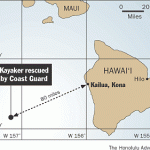If you are in VHF radio contact with the Coast Guard or Coast Guard Auxiliary, they may direct you to switch to a channel followed by the word “alpha”. What does the “alpha” designation mean?
Answer: Alpha designates that your radio must be set on “U. S.” rather than “International” to receive and transmit.
When very cold air moves over warmer coastal water, wisps of visible water vapor may rise from the surface as the water “steams”. In extreme cases, this type of fog can rise hundreds of feet above the surface. It’s called ________.
Answer: Frost Smoke, or Arctic Sea Smoke.
What is the name of the most reliable and effective gasoline fume detection system you can have aboard your vessel, and how is it activated?
Answer: Your nose, and it is of course activated by “sniffing”.
An alternative to a drogue when running before a sea, is to tow a long length of heavy line with nothing attached to the end. It will act as a brake, help keep the boat running straight, and help quiet the sea astern of the boat. What is this name for this line?
Answer: A Warp (Many of you answered “storm anchor”. Note that the question states that nothing is attached to the end of the line.)
Within one knot, what is the speed of sound in 3.485% saltwater at 60 degrees F.?
Answer: 2,930.05 knots
Proceeding up the Mississippi River, you spot a nun buoy which is obviously off station and adrift. Your alert to other boaters by VHF marine radio should be prefaced with the word ___________
Answer: Securite (pronounced Se-cure-ih-tay’)
The crew of an icebreaker is watching a large ‘hummock’ off the starboard bow. What are they looking at?
Answer: A hummock is a ridge of broken ice which has been forced upwards by pressure.
An aircraft circles your vessel three times while gunning its engine, and then heads off in a northwesterly direction. What is the pilot signalling?
Answer: “Please proceed as rapidly as possible in a northwesterly direction. There is a vessel in distress or other emergency requiring assistance.”
A Weaver’s Knot is known by seamen as the common ____________!
Answer: Sheet Bend
In the North Atlantic, they’re called hurricanes; in the North Indian Ocean, cyclones. But the Australians occasionally use a different name for what we in North America call tropical cyclones. What is it?
Answer: Willywah, Willie-Willie, Willy-Willy, Willi-Willi or anything similar.
What is the purpose of a “Napier Diagram”?
Answer: It’s a diagram used to plot deviations of a compass against headings, and to convert compass and magnetic headings.
If “UT” is the abbreviation for Universal Time, then what is “CUT”?
Answer: Coordinated Universal Time
What are the light characteristics of a nav aid when it is shown on the chart as “ISO”, for ISOPHASE.
Answer: All durations of light and darkness are of equal length.
What is the name of the law used to determine the center of a low-pressure system from wind observation? (when facing the wind, the center of low pressure is to your right in the Northern Hemisphere).
Answer: “Buys Ballot’s Law”
Under the Oil Pollution Act of 1961, prohibited zones are generally areas within how many miles of shore?
Answer: 50 miles
On a nautical chart, you see an indication of the quality of the bottom, marked as “fly”. What bottom quality characteristic can you expect?
Answer: “Flinty”
What are (were) “thole pins”?
Answer: Pairs of vertical pins, set in the gunwales of a pulling boat (rowboat) in which the oars were set.
The “plow” anchor was designed by Professor G. I. Taylor of Cambridge University in England. He called it the “CQR”. What do the initials “CQR” stand for?
Answer: “CQR”, if said rather quickly, stands for the word “SECURE”
A single line of position, when combined with a dead reckoning position, results in a/an:
Answer: estimated position
What is a Kamal, and what is its basic construction?
Answer: A navigation instrument consisting of a piece of string attached to a block of wood. The device is used with the measured string held in the navigators teeth, and the block of wood stretched to the string’s length.
In a Williamson turn, the rudder is put over full until:
Answer: the vessel has turned 60 degrees from its original course.
How many feet of chain has a vessel laid, when it has paid out two “shot”?
Answer: 180 feet (a “shot” is 15 fathoms, or 90 feet)





